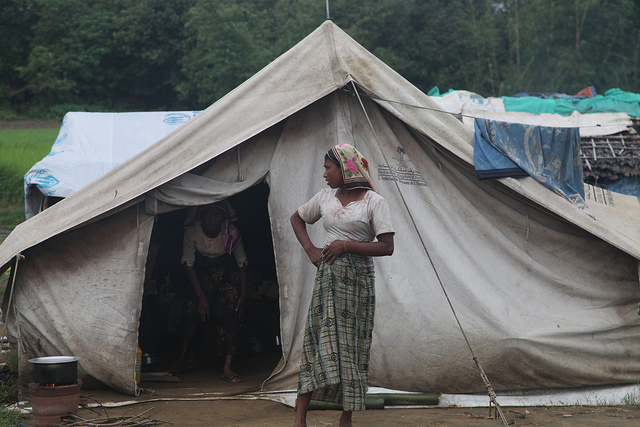
In August 2013, the Sentinel Project published an analysis of patterns of violence against Muslims in Burma entitled “A Formula for Ethnic Cleansing in Burma.” The article described the uncannily systematic means by which the Rohingya were being killed and ethnically cleansed from their ancestral homes in Rakhine state and throughout Burma. The violence over the past few days in Kila Dong, near the locus of much anti-Muslim violence, Maung Daw, has showed the continuance of the same pattern of ethnic cleansing noted in previous incidences.[1]
Burma’s ethnic cleansing campaigns in recent history have always begun with an alleged or real crime. Then, without verifying the the details of the crime, and with the help of state media which shapes public perception, a mob forms, usually outside a police station if a suspect is held. This is always a prelude to violence against Muslims with no connection to the alleged criminal. If no suspect is held, the organized mob carries out ethnic cleansing in “retaliation” for the crime without first demanding to lynch the subject in police custody. Although police have refused to hand over alleged suspects to the angry crowds, security is always provided for the mob’s campaign by the police (Hlun Htaine) or other paramilitary units. In some cases, armed forces have been caught participating in violence against Rohingya.
As outlined in the Sentinel Project’s August 2013 report, the justification for violence is almost always a crime committed or alleged to be committed by a Muslim. This crime is not always real, and in at least one high profile case, was actually fabricated with the help of the government and state-controlled media. The violence in Rakhine state following the alleged rape and murder of a Rakhine woman by three “Muslim” men was distorted in order to incite “secterian” violence against Rohingya. The government forced the examining doctor to falsify a report alleging the woman had been sexually assaulted, and the resulting news story spread the falsehood that the rape occurred and that the men were Muslim when at least one was in fact Buddhist.[2]
In another case, on August 27, 2013, the “crime-and-spontaneous-appearing-reaction” formula was transparently employed, but failed. Elements including Buddhist Monks in Thandwe township attempted to incite violence first by attacking Muslim boys while feeding their goats, and then by using a masked man to attack a woman from a motorcycle. According to the formula, they would later try to claim the motorcycle attacker to be Muslim, providing a justification for mobs to conduct ethnic cleansing.[3]
Predicting Outbreaks of Violence
Above we see that the patterns of violence, the “how” of Burma’s ethnic violence, are consistent and predictable. Also, the Sentinel Project’s geospatial mapping software, ThreatWiki, has proven accurate in predicting the general location of future anti-Muslim violence.[4] For example, ThreatWiki showed a staggering 30 incidences of anti-Muslim violence in Maung Daw township between May 2013 and December 2013, exponentially higher than any other place in Rakhine state (where the Muslim population is highest) or greater Burma. The real number of incidents is likely much higher, with only a small proportion of verified reports making it out of the tightly controlled channels in violence-prone areas. What has become increasingly difficult to predict, is not so much where, or how, but when these campaigns will take place. The tempo of violence in the fall of 2013 did not continue steadily into winter; rather, the latest incident in Kila Dong appeared almost a month after a 969-affiliated Monks rallied in Maung Daw, using loudspeakers to advocate for the expulsion of all Rohingya in December.[5]
If ethnic cleansing is truly conducted at the Burmese government’s whim, behind closed doors with the involvement of Burma’s extensive intelligence apparatus, plainclothes police, and politically-embattled military leaders, predictability may not be a realistic goal. Instead, methods of communication must be developed to retrieve reliable information from heavily controlled zones to expose the crimes-against-humanity being committed with near-impunity in Rakhine State. International pressure can then be placed on Burma to a greater degree, frustrating the government’s attempts to deny that the violence is actually taking place and its plight to conceal its own role in instigating, protecting, and participating in the violence.
[1] http://abcnews.go.com/International/wireStory/group-myanmar-mob-kills-dozen-muslims-21554826
[2] https://www.dvb.no/analysis/did-the-govt-incite-the-racial-violence-targeting-the-rohingya/24116
[3] http://www.rvisiontv.com/updates-some-monks-attempted-to-trigger-violence-in-than-dwe-today/
[4] http://threatwiki.thesentinelproject.org/burmavisualization
[5] http://www.theguardian.com/world/2014/jan/17/myanmar-government-denies-buddhist-mob-killed-muslims
